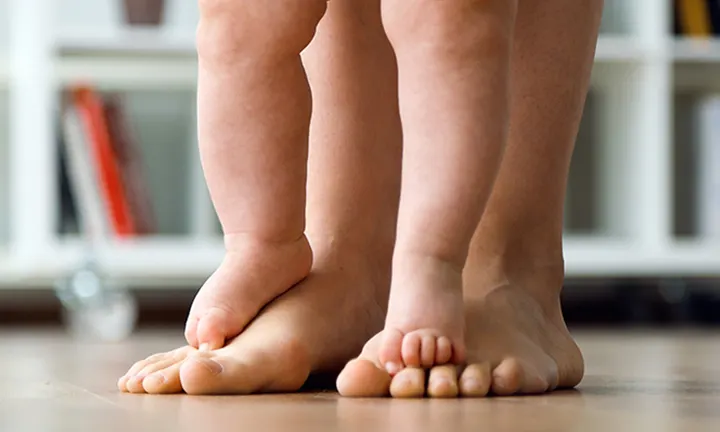Baby Ingrown Toenails
When you’re bathing your little one (or holding their foot and chanting the nursery rhyme "This Little Piggy Went to Market"), you might notice that that they have what looks like an ingrown toenail. Is it really an ingrown toenail? What do you need to do about it? And why did it even happen in the first place? These are just some of the frequently asked questions we answer here.
What Is an Ingrown Toenail?
An ingrown toenail occurs when the corners of the nail grow into the surrounding skin. It’s more likely to happen with the big toe than with the other toes.
Can Babies Get Ingrown Toenails?
Yes, your baby can develop an ingrown toenail, but the nail can also appear to be ingrown without it actually being ingrown. This is because baby nails, which are soft and pliable, may curve in at the edges. Unless the toenail is red and swollen, it’s not necessarily ingrown. If you’re unsure whether your baby has an ingrown toenail or not, your little one’s healthcare provider can tell you by taking a look.
What Are the Signs and Symptoms of an Ingrown Toenail?
These are some of the signs that your baby may have an ingrown toenail:
Redness and swelling of the area
Pain or tenderness around the toenail, especially when touched
Pus or yellow fluid where the toenail is ingrown
A feeling of pressure when wearing shoes (keep in mind your little one needs shoes only once they're walking outside; read more about your baby’s first shoes here).
What Are the Causes of an Ingrown Toenail?
Ingrown toenails can develop when:
The toenail is so sharp that it digs into the skin, leading to an infection
The corners of the toenail keep growing deeper into the toe
The toenails have been trimmed too short or the edges have been rounded
Shoes are too tight (in older babies and children).
How Do You Treat Your Baby's Ingrown Toenail?
In cases where only the skin around your baby’s toenail is red and swollen, and there is no oozing pus and your little one doesn’t have a fever, you can try this home remedy:
Soak your baby's toes in warm soapy water for 20 minutes twice daily (never leave your baby unattended in or near water; plan to be with them this whole time)
While soaking, massage the swollen area around the cuticle (the skin next to the nail)
Try to gently bend the toenail up and out of the cuticle
Dry your baby’s foot completely
Use an over-the-counter antibiotic cream on the affected toenail area to help prevent or treat an infection.
How Can You Prevent Your Baby Having Ingrown Toenails?
Here’s how you can help prevent your baby from getting an ingrown toenail in the future:
Always trim the toenails straight across
Don’t round off the corners
Don’t cut the toenails too short
After baths, your baby’s toenails will be soft, which is the best opportunity to check on them and bend the corners upward if they appear to be starting to grow inward.
What Can Happen If You Leave an Ingrown Toenail Untreated?
Other than just being sore and uncomfortable for your little one, an ingrown toenail left untreated can lead to an infection. Infections can be serious, especially if your baby has other underlying health conditions.
When Should You See Your Baby’s Healthcare Provider?
You should see your baby’s healthcare provider if your baby’s ingrown toenail gets infected. If the toenail is red, swollen, tender to the touch, and seems to be draining pus, it’s most likely infected.
Your baby’s healthcare provider may remove the ingrown part of your baby’s nail so that it can heal easily and may prescribe an antibiotic to treat the infection.
If your baby develops a fever, if the redness seems to spread beyond the toe, and if your little one's symptoms do not improve from at-home treatment after a week, contact your baby’s provider immediately.
The Bottom Line
Seeing your baby with an ingrown toenail may be disconcerting at first glance, but an ingrown toenail can be treated effectively at home or with treatment from your baby’s healthcare provider. It’s always a good idea to treat the ingrown toenail sooner rather than later to prevent a more serious infection forming.
At-home treatment can include soaking the nail and trying to lift it out of the cuticle. If this doesn’t seem to help, a trip to your baby’s provider may be in order, and the nail will be back to normal in no time.
How We Wrote This Article The information in this article is based on the expert advice found in trusted medical and government sources, such as the American Academy of Pediatrics and the American College of Obstetricians and Gynecologists. You can find a full list of sources used for this article below. The content on this page should not replace professional medical advice. Always consult medical professionals for full diagnosis and treatment.
Join a World of Support
through Pregnancy and Parenthood.
TRACK WITH TOOLS
LEARN WITH EXPERTS
GET REWARDED




